Vapor Reference Cells(日本では販売しておりません)
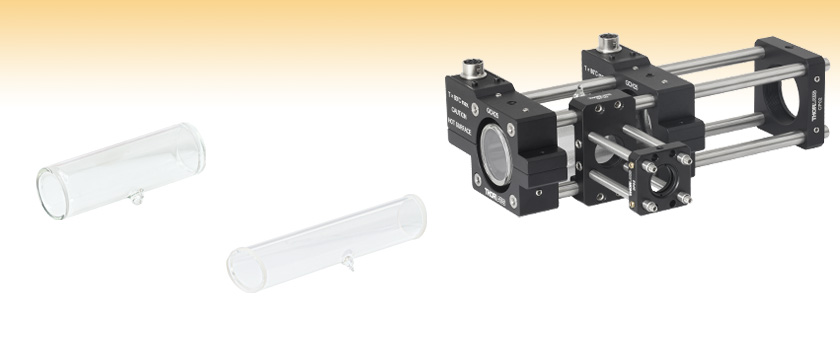
- Different Vapors for Frequency and Wavelength Reference
- Cells Made from Either Quartz or Borosilicate
- Custom Reference Cell Capabilities
GC25075-RB
Ø25.4 mm Borosilicate Cell with Rubidium Gas
GC19100-I
Ø19 mm Quartz Cell with Iodine Gas
Application Idea
The perpendicular 16 mm cage system mounted using the SP30 Adapter Plate can be used to detect fluorescence from the vapor cell, which is mounted in a GCH25-75 Glass Cell Heater.

Please Wait
 Figure 1.1 Absorption Spectroscopy Schematic
Figure 1.1 Absorption Spectroscopy SchematicFeatures
- Vapor Cells for Frequency and Wavelength Reference
- Borosilicate Glass Reference Cells
- Cesium (Cs)
- Potassium (K)
- Sodium (Na)
- Rubidium (Rb)
- Quartz Glass Reference Cells
- Cesium (Cs)
- Iodine (I)
- Rubidium (Rb)
- Enhanced Rubidium 87 (87Rb)
- Glass Cell Heaters Available
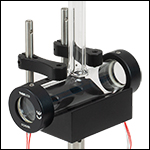
Click to Enlarge Figure 1.2 GC251 Glass Cell Shown
with Two GCH25R Heater Caps
Reference cells contain vapors of specific atomic elements or molecular compounds, each of which has a well-defined absorption spectrum. These cells are commonly used in spectroscopic applications such as tunable diode laser calibration, stabilization of laser frequencies, and calibration of wavelength meters. Thorlabs offers both borosilicate and quartz reference cells that contain a range of standard fill materials. Custom reference cells can be manufactured upon request.
Since each fill material is associated with a unique absorption spectrum that serves as its fingerprint, the contents of a reference cell can be determined via a linear absorption measurement (as depicted in Figure 1.1). By scanning a tunable diode laser over a wavelength range and detecting light absorption (A) with a photodetector, a series of peaks will be recorded, which is characteristic of the vapor inside the cell.
All of the cells offered here are baked and evacuated to 10-8 Torr prior to filling in order to remove contaminants. Additionally, each cell is helium leak checked to ensure the longevity of the vapor cell. The vapor pressure of the alkali metal will cause it to migrate throughout the cell and condense at the coolest area. Heating the windows of the cell rather than the cell body will help ensure the windows stay warmer and thus that the alkali will collect elsewhere. If obstruction of the optics becomes an issue, apply cooling to an area on the cell body, such as near the fill stem, and heat the windows in an alternating fashion to drive the metal from the window surfaces and collect it at the cool spot. The metal may eventually move back to the windows depending on how the cell is heated.
Mounting & Heating Options
These cells can be mounted in our V-Clamp Mounts, which are available in standard, kinematic, or Ø1.5" post-compatible versions. Please check that the cell diameter is supported by the mount. Our VBC1(/M) and VBC2(/M) Post-Mountable Band Clamps provide a distributed clamping force that is well-suited for holding glass cells without marring. The cells can be heated using the GCH25-75 Glass Cell Heater, illustrated in the Application Idea at the top of the page, or the GCH25R Heater Caps, shown in Figure 1.2.
Our HT10K and TLK-H Resistive Foil Heaters wrap around Ø25.4 mm glass cells and feature adhesive backing.
Related Items
We also offer sealed acetylene reference cells for frequency and wavelength calibration. Also available are pre-assembled compact and Herriott multipass cells for gas absorption spectroscopy applications as well as empty glass cells, glass cells with angled windows , glass cells with Brewster windows, glass cells with textured windows, and threaded glass or stainless steel cells for custom spectroscopic applications.
Borosilicate Reference Cells
| Specifications | |
|---|---|
| Material | Borosilicate Glass |
| Cell Diameter | 25.4 mm (1.00") |
| Cell Length | 71.8 mm (2.83") |
| Pressure @ 25 °C | >10-7 Torr |
| Fill Stem | <10 mm (<0.39") |
| Window Angle | 0° |
| Window Type | Flat |
| Window Thickness | 1.6 mm (0.06") |
| Clear Aperture | >Ø20.0 mm (>Ø0.79") |
| Minimum Transmission (350 nm - 2.2 µm) | >84% |
| Vapor | Typical Wavelength |
| Sodium (Na) | 589 nm |
| Potassium (K) | 764 nm |
| Rubidium (Rb) | 780 nm |
| Cesium (Cs) | 852 nm |
Quartz Reference Cells
| Item # | GC19075-CS | GC19100-I | GC19075-RB | GC19075-RB87 |
|---|---|---|---|---|
| Material | Quartz | |||
| Cell Diameter | 19.0 mm (0.75") | |||
| Cell Length | 75.0 mm (2.95") | 100.0 mm (3.94") | 75.0 mm (2.95") | 75.0 mm (2.95") |
| Pressure @ 25 °C | > 0.1 - 1.2 Torr | |||
| Fill Stem | <10 mm (<0.39") | |||
| Window Angle | 11° ± 1° | |||
| Window Type | Wedged 2° | |||
| Window Thickness | 3 mm (0.12") | |||
| Window Surface Quality | 60-40 Scratch-Dig | |||
| Window Flatness | λ/4 | |||
| Posted Comments: | |
Tadas Buciunas
(posted 2025-04-22 12:27:12.45) Hello,
we are currently looking for spectrally sharp wavelength calibration reference for our built ECDL based spectrometer. Could you please advise if using Your vapor reference cells could be of use? We work at 2050 - 2400 nm range, so having many sharp spectral lines in this region would be great. Which of the gas cells would you recommend? Could you provide me with transmission or absorption spectra of gas cell in this spectral region? could you provide me with a specification sheet? What S/N is required to measure such samples? Thank you! tdevkota
(posted 2025-04-28 02:07:53.0) Thank you for contacting Thorlabs. You can find our current offerings listed on the product page. Requests for additional specifications or custom reference cells can be made by emailing us at techsupport@thorlabs.com. I have reached out to you directly to further discuss your application. user
(posted 2024-11-20 11:27:39.457) Cs atoms' vapor pressure is much higher than 87Rb about 5 times. So I think more shorter version of Cs wedge cell is very useful for compact spectroscopy system. EGies
(posted 2024-11-25 11:38:21.0) Thank you for your feedback! I have added your request to our internal engineering forum for future consideration. I have also reached out to you directly to discuss the needs of your particular application. Alok Singh
(posted 2023-11-24 12:05:26.487) Dear Thorlabs Team,
I assume in specs sheet the mentioned pressure is for the pressure of Rb vapor.
The pressure is 10^-7 Torr for borosilicate tube and >0.1 Torr for quartz tube and in MSDS sheet it is showing Density at 20 °C (68 °F): 1.532 g/cm³ for both the cell.
Are the amount of Rb is different for both the cell? jpolaris
(posted 2023-12-19 07:45:29.0) Thank you for bringing to our attention the discrepancy in the pressure specifications between our borosilicate and quartz vapor reference cells. Both the borosilicate and quartz versions of these cells are evacuated and sealed closed while actively pumping in the 1E-8 range. As the stem is heated to collapse, the manometer reads in the low 1E-7 range. Once the cell is sealed, there is a natural vapor pressure inside the cell which increases with temperature. We do not have hard data on the vapor pressure inside the cells. However, we do know that there is 2 mg - 5 mg of alkali metal within both cells. Marino Maciel
(posted 2022-12-09 15:09:34.383) Dear Thorlabs team,
do you have information related to the lifetime of the Rb vapor inside the cell?
I really appreciate any help you can provide.
Marino cdolbashian
(posted 2022-12-15 02:53:54.0) Thank you for reaching out to us! We unfortunately do not have lifetime spec for these cells. We have had customers in the past report constant use for 6 weeks until the reference signal was no longer viewable, though they were a bit brief in the conditions in which they were testing. We recommend use at 80-125C as higher temps will cause the alkali metals in the reference cells to react with the glass tube at a faster rate, thus diminishing the lifetime of the reference signal. ximeng zheng
(posted 2020-12-17 07:22:27.167) Dear Sir/Madam,
For a customized vapor cell, I would like to know the minimum ID of the Rb reference cell you can provide? Is it possible to fabricate a 500mm long vapor cell in parallel? How is the lifetime reduced with a thin SiO2 wall?
Otherwise, one question for the pressure level of the reference cell, why it is 10^-7 Torr for borosilicate tube and >0.1 Torr for quartz tube?
Thank you in advance and best regards,
Ximeng ZHENG YLohia
(posted 2020-12-24 11:25:38.0) Hello Ximeng, custom vapor cells can be requested by emailing techsupport@thorlabs.com. I have reached out to you directly to discuss this further. Hugo P.
(posted 2020-10-14 09:52:03.97) Hello, I've been using two of your quartz reference cells for atomic magnetometer applications, 87Rb and Cs. I have read in one of the comments below that it is advised to operate them below 110ºC. Can you confirm me if this is the case for both cells I'm using? Nevertheless, I have been heating them up to 70~80ºC and I noticed that both Rb and Cs have deposited on the angled walls of each of the cells; does this mean that I have damaged the cells in some way or are they still functional? YLohia
(posted 2020-10-15 11:04:27.0) Hello, thank you for contacting Thorlabs. Although there have been no published papers to our knowledge on the topic of alkali reaction with glass in excess of 110C, we have plenty of anecdotal evidence the phenomenon does occur. The reaction is slow at 110C but the higher the temperature, the faster the reaction until all the metal is consumed. Due to the chemical composition, the reaction with Pyrex (borosilicate) is slower than with quartz (silicon dioxide). Operation at 70-80C should provide many years of trouble-free use.
Each cell is He leak checked to ensure UHV compatibility prior to being added to a vacuum manifold. The cells are baked out and evacuated to 1E-8 Torr prior to the addition of alkali metal. Under 1E-7 Torr and lower, alkali metal has a natural vapor pressure and will migrate throughout the cell to find the coolest area to condense. Heating the windows of the cell rather than the cell body will help ensure the windows stay warmer and thus the alkali will collect elsewhere. If obstruction of the optics becomes too big of an issue, apply a cool spot to the cell body, perhaps at the fill stem, and heat the windows in an alternating fashion to drive the metal from the window surfaces and collect it at the cool spot. The metal may eventually move back to the windows depending on how you are heating the cell. The fact that you can see metal in the corners means the cells are perfectly fine. user
(posted 2019-11-18 14:52:48.737) Hello,
Regarding the Rb87 cell, I'm undergoing a master's dissertation where I'm trying to study the influences of light and magnetic fields on the vapour cell. My project funded the cell you have currently commercially available. I've been using it for a while and I can attest that the manufacturing is remarkable and well done, I've had no issues with it whatsoever.
I have a few questions I've been struggling to get cleared up and I'm wondering if you know the values of relative permitivity, relative permeability and electrical conducitivity of the vapor of Rb87 you have in your cell.
Also, I've downloaded your CAD files in order to use the model to import in COMSOL and after trying to re-edit on Solidworks I can't seem to access all the functionalities of the software with the files you provided. I wanted to fill the interior of the cell with a solid, because in COMSOL, so that magnetic field equations become appliable I need a volume inside the cell, not a surface around, and I haven't managed to do so because it simply doesn't let me. I was wondering if you had a model like that or could quickly sort one out.
I am extremely sorry for the long text and the plentiful of questions I have asked. If you don't have an answer for them it's alright, I'm just trying my best to gather the information I need to do a good project, as the literature doesn't cover certain aspects.
Best regards. YLohia
(posted 2019-11-19 08:47:02.0) Hello, thank you for contacting Thorlabs. We are glad to hear that your experience with our GC19075-RB87 has been good. We will reach out to you directly to discuss your application further. Seokjin Kim
(posted 2019-08-19 04:24:26.477) Dear Sir or Madam.
Hello.
Since I saw that thorlab could make custom cell with request, i send a email.
Could we make custom cell with below condition?
1. Polygonal column(like triangular, rectangular and etc)
2. AR coating for all plane or plat window for cylindrical cell.
3. Cs with 500torr ethane buffer gas.
Thank you.
Best regards,
Seokjin Kim YLohia
(posted 2019-08-20 08:30:25.0) Hello Seokjin, custom vapor reference cells can be requested by emailing techsupport@thorlabs.com. We will reach out to you directly. fshlomo
(posted 2018-11-26 02:26:14.967) Hi,
Actually a question, could you please quote for an optical cell with 129I or 127/129I ratio, spectroscopic research of the hyper fine structure shifts of the two isotopes.
Salomon Fastig YLohia
(posted 2018-11-26 10:01:52.0) Hello Salomon, thank you for contacting Thorlabs. Custom vapor reference cells can be requested by emailing techsupport@thorlabs.com. We will reach out to you directly to discuss your requirements and the possibility of a quote. b.goldberg
(posted 2018-03-29 16:24:34.117) I'm interested in the I2 cell, but concerned with the statement of, "Although quartz will survive temperatures up to 800 °C, the reference vapor will be consumed by reactions with the wall of the cell at temperatures significantly lower than quartz's melting temperature."
I want to use the cell at near room temp. Is the suggestion that I would be losing I2 there?
Additionally, it seems that the cell has a small pressure of the I2 vapor and some buffer gas. What is the pressure of the vapor and the pressure of the buffer gas?
Lastly, can you send my a reference spectra at 18788 cm-1 nm? nbayconich
(posted 2018-04-02 10:40:08.0) Thank you for contacting Thorlabs. For the Iodine vapor reference cells there is no indication that the Iodine vapor will react with the quartz cell or glass at any temperature. Most reactions occur with alkali metal vapor reference cells at high temperatures around 110 degrees Celsius. The quartz cell alone can handle temperatures up to 800C however we recommend the operating temperature of the vapor inside the reference cells to be below 110 degrees Celsius for any reference cell using an alkali metal vapor such as Cesium or Sodium. These cells are sealed at a pressure of 1 x 10-8 Torr 25 °C and the buffer gas is helium.
We do not have any reference spectra at the moment for these particular iodine vapor cells but I will reach out to you directly with some references. aspitarte
(posted 2018-02-13 16:47:13.76) I am currently trying to measure the transmission of these quartz vapor tubes containing Potassium, Sodium, Rubidium, and Cesium. I would appreciate transmission data on these tubes at room temperature and elevated temperatures, if possible. Thank you. YLohia
(posted 2018-03-29 03:39:42.0) Hello, thank you for contacting Thorlabs. We will reach out to you directly to discuss the possibility of performing these tests. hoeffner
(posted 2017-11-04 11:53:22.35) My application is a Faraday-cell which is a potassium cell operating at high temperatures up to 140°C with a magnetic field of ~2000 Gauss. Different to reference cells such a cell is a extrem narrowband filter of a few pm depending on the combination of temperature and magnetic field. Is it possible to achieve such high temperatures with the controller/heater? Can they be modfied according to this requirements?
regards
J. Hoeffner tfrisch
(posted 2018-01-03 02:06:17.0) Hello, thank you for contacting Thorlabs. Unfortunately, our GCH25-75 is only suitable up to 50°C. I can reach out to you directly about your applications. peter.a.ketteridge
(posted 2017-09-28 15:45:57.21) Can you supply me with absorption spectra for cell GC19075-CS.
The pressure stated at 25C is the filled cell with residual air only...as its below Cs melting.
What is the mass/molarity of Cs in the cell as supplied?
Thanks for help. tfrisch
(posted 2017-12-04 04:53:09.0) Hello, thank you for contacting Thorlabs. Cs will be gasseous at such low pressure. The cell is sealed at about 10^-8 Torr, and the Cs purity is better than 99.99%, so there would be no contamination from air or other materials. I will reach out to you with typical absorption data on Cs. mugreen
(posted 2016-07-07 08:03:21.22) Hello. I'm a graduate school student in KAIST, South Korea.
I found that custom reference cell can be manufactured from the Overview of the Gas reference cells.
Actually I'm finding a Borosilicate reference cell doubly filled with Rb and Cs, with other properties same with the other products.(size, etc.) I need this cell to do an experiment with femtosecond laser in this Summer.
Please let me know whether it is possible to make.
Thanks.
Sincerely,
Min-Hyuk Kim nfredman
(posted 2016-06-14 14:53:03.22) We've made a small oven for our rubidium vapor cell to keep it at 40 C to improve the absorption spectrum, but some of the rubidium has started to condense on the exposed windows, and cloud our view. Any permanent solutions on reducing condensation? besembeson
(posted 2016-06-15 02:46:29.0) Response from Bweh at Thorlabs USA: You would need to improve your heating design to include the windows. You could improvise a means to achieve this, or maybe consider our GCH25-75 that is designed to uniformly heat the entire cell. eddie.ross
(posted 2016-05-06 04:18:02.45) Could you please provide a rough mass estimate of the GC25075-NA cell?
Thanks. besembeson
(posted 2016-05-10 02:44:04.0) Response from Bweh at Thorlabs USA: If you are interested in the sodium mass, this will be typically 5-10 mg. JHansell
(posted 2016-02-02 10:12:40.903) What is the lifetime of the cell?
Does the Iodine react, get absorbed or leak over a period of time? besembeson
(posted 2016-02-04 02:12:25.0) Response from Bweh at Thorlabs USA: These should last for a very long time. To our knowledge, there is no reaction between the glass and the iodine. The only consideration is the rate of He (buffer gas) permeation until naturally occurring atmospheric levels (equilibrium) is reached. marries
(posted 2015-11-16 09:57:03.047) Please could you let me know if there is an MSDS or COSH health and safety leaflet for the Rb cells. Also what is the quantity of Rb in a cell?
Regards
Mark Farries besembeson
(posted 2015-11-19 09:47:01.0) Response from Bweh at Thorlabs USA: Yes we have the MSDS safety leaflet at the following link: http://www.thorlabs.com/thorcat/24000/GC25075-RB-MSDS.pdf. The quantity of Rb in a cell is typically 5-10mg. cg8
(posted 2015-10-30 08:40:28.21) Do you make any of the molecular reference cells referenced? In particular, we are interested in hydrogen chloride. besembeson
(posted 2015-11-04 05:38:32.0) Response from Bweh at Thorlabs USA: We provide several special reference cells with different molecules but we don't do HCl at this time. aw00239
(posted 2015-07-21 11:39:05.06) Hi, can anyone advise me on the possibility of custom cells? I'm looking for some cells that are similar to your Rubidium products but have different specs. Thanks in advance for you help besembeson
(posted 2015-07-23 05:56:46.0) Response from Bweh at Thorlabs USA: We can provide custom cells with different reference gases, pressures and dimensions. I will follow-up by email regarding providing this to you. marina.kauffeldt
(posted 2015-02-27 16:19:36.21) I have a questions concerning the absorbtion spectrum of the iodin cell. Do you have any overiew spectra for the wavelength region fo 520-540 nm? If yes it would be very helpful if you can provide me the spectra or any references to such spectra!
Thank you for your help in advance! besembeson
(posted 2015-03-26 04:14:26.0) Response from Bweh at Thorlabs USA: We don't have this currently and we typically have not been collecting spectra from users that we can share. I will email you a few helpful links regarding reference spectra. yogeshwar.kale
(posted 2014-12-10 00:30:52.643) Dear Sir/Madam,
Can you able to provide the gas cells similar to GC25075-Na for the atomic hydrogen gas filled in it?
Regards,
Dr. Y. B. Kale
RRCAT, Indore, India jlow
(posted 2014-12-11 11:12:38.0) Response from Jeremy at Thorlabs: We can provide custom gas reference cells upon request. I will contact you directly to discuss about your requirements. johannes.wein
(posted 2014-05-09 13:05:13.603) Is it possible to get the transmission values for GC19075-RB at wavelengths:
193,420,1323,1366,1475,1528 nm?
The transmission curves are to small to get any accurate numbers out of it. besembeson
(posted 2014-05-15 09:02:27.0) Response from Bweh E at Thorlabs: I will be sending you the excel data file by email for that plot. We will subsequently include this data on the website. Thanks for bringing this to our attention. cbxie
(posted 2014-03-19 10:21:36.977) I want to check if only one TC200 (with one output) can control the GCH25-75 with two heat elements (there have two 6-pin connectors). jlow
(posted 2014-03-19 08:06:05.0) Response from Jeremy at Thorlabs: Yes, you only need one TC200 to drive both heating elements in the GCH25-75. There's a main output and an auxiliary output on back of the TC200. The auxiliary output is detailed in Chapter 11 of the manual. Varberg
(posted 2013-06-16 00:10:03.267) I am wondering if you can make me a quartz iodine cell that is 500 mm long ( instead of the standard 100 mm). Thanks. tcohen
(posted 2013-06-19 17:49:00.0) Response from Tim at Thorlabs: Thank you for your inquiry. Yes, we can provide this. Custom requirements can be discussed and quoted directly through our applications engineers at techsupport@thorlabs.com. cbxie
(posted 2013-03-07 03:34:51.337) I want to order the I2 cell for research, but I can not find the suitbale one in the product list. Could your company produce the I2 cell for our specialization-Diameter of 25mm and Length of 400mm. jlow
(posted 2013-03-07 12:35:00.0) Response from Jeremy at Thorlabs: We could possibly make this depending on the specs needed. I will get in contact with you to discuss about this directly. jlow
(posted 2012-08-23 08:10:00.0) Response from Jeremy at Thorlabs: We are able to customize our gas reference cells. I will get in contact with you directly regarding this. zelensky
(posted 2012-08-23 09:35:29.0) I need RB87 cell with buffer gas (e.g. Ne, 5-30 torr) Is this option available? jlow
(posted 2012-08-16 11:24:00.0) Response from Jeremy at Thorlabs: These gas reference cells must be shipped with a hazardous cargo charge and specifically it must be sent via FedEx Air Freight Cargo as the mode of delivery. This is a regulation and there is no way that we can circumvent this. I will get in contact with you to discuss more about this. scholten
(posted 2012-08-15 23:57:25.0) Good to see these as being available again. However, do you charge "Hazardous cargo" shipping charges for these? To ship to Australia, other suppliers say they must specify hazardous cargo, which means they cannot go on passenger planes, and the additional cost is very high (approx. $500). If you can circumvent that it makes your cells significantly lower in cost.
Thanks user
(posted 2011-11-23 17:24:16.0) A response from Tyler at Thorlabs: Hello acable, Unfortunately we recently discontinued our line of gas cells and as a result this page is no longer a good place to put this data. If you already have a reference cell from us could you please contact our technical support group and they will provide you with any absorption data we have. acable
(posted 2011-11-19 18:13:55.0) The catalog page gives some absorption plots, would it be possible for you to post these to the web for easy access. bdada
(posted 2011-08-24 14:28:00.0) Response from Buki at Thorlabs:
Thank you for your feedback. Our Sales Department will contact you to discuss shipping methods. ding
(posted 2011-08-23 19:05:55.0) I am not able to buy the water vapor cell in the Netherlands. I was wondering if I can ask someone to order it in US and bring it to Europe with him. How long does it take to ship it within US? Shall I expect long waiting period even in US? Thanks a lot! technicalmarketing
(posted 2007-11-26 08:22:01.0) Dear Kevin, The yellowish gold film that you see on the cell is most likely condensed Na. As you heat the cell, the vapor pressure increases, causing the vapor will coat the cell walls themselves. If you blow warm air onto the areas of the cell where this condensation has occured using a heat gun (or even a hairdryer) while keeping the rest of the cell cooler, youll be able to remove the condesed vapor from the surfaces that you need access to for your experiment. Kevin.lyon
(posted 2007-11-21 11:50:22.0) We have purchased this cell along with the heater GCH09-150 and the associated controller. The cell works fine however the heater was only rated for 80 C which does not provide hardly any vapor pressure for sodium. It may be enough if you are looking at absorption however for any fluorescence it is insufficient heat. We then used heater tape to heat the cell to around 150 degrees and got the results we needed however the cell turned an odd yellowish gold. I am not yet sure what reaction may be responsible for this however the cell still provides an atomic sodium spectra despite the discoloration. |

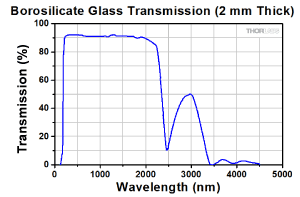
Click to Enlarge
Figure G1.1 Borosilicate Glass Transmission
These reference cells are fabricated from borosilicate glass, a rugged material known to resist chipping and cracking. They are tested to ensure that the transmission through the cell exceeds 84% for light in the 350 nm to 2.2 µm range.
MSDS sheets are available and can be found by clicking on the red Docs icon (![]() ) below.
) below.
To apply heat to the cell, consider our selection of glass cell heaters.


Click for Full Dimensions
Figure G2.1 Note that for the iodine reference cell GC19100-I, the length is 100.0 mm rather than 75.0 mm.
Thorlabs' quartz reference cells feature UV fused silica windows for superior transmission in the UV spectral range. The windows, which are angled to compensate for beam offset, are designed with a 2 degree wedge so as to eliminate etalon effects.
The rubidium reference cell (GC19075-RB) is sold with the natural isotope ratio of Rb, which is 72.15% 85Rb and 27.85% 87Rb . A version is also available with 98% pure 87Rb (GC19075-RB87).
Although quartz will survive temperatures up to 800 °C, the reference vapor will be consumed by reactions with the wall of the cell at temperatures significantly lower than quartz's melting temperature.
MSDS sheets are available and can be found by clicking on the red Docs icon (![]() ) below.
) below.
To apply heat to the cell, consider our selection of glass cell heaters.
 Products Home
Products Home

























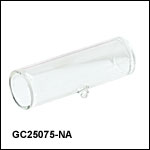
 ズーム
ズーム
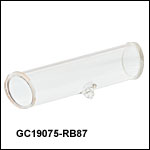
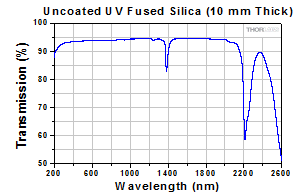
 Vapor Reference Cells
Vapor Reference Cells